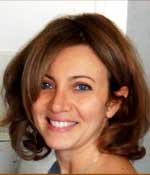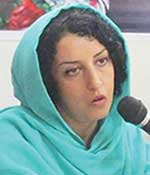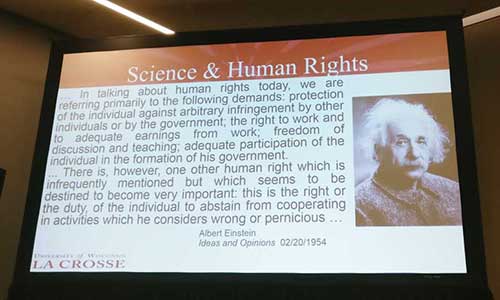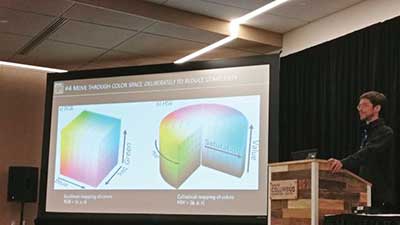Report from the April Meeting 2018
Maria Longobardi, Chair

The “Physicists and Human Rights” session was organized in collaboration with the Forum on International Physics (FIP) and chaired by Cherrill Spencer, the FIP Past Chair 2018. We had the pleasure of hearing the speeches from the two winners of the 2018 Andrei Sakharov Prize, Ravi Kuchimanchi and Narges Mohammadi (presentation on her behalf given by Nayereh Tohidi).
Ravi Kuchimanchi used his physics knowledge to help those in need in India with the Association for India’s Development (AID). Narges Mohammadi is currently serving a 16-year sentence in Iran and sacrificed her scientific career and liberty speaking up for the rights of others in her country.
The third speaker was Shelly R. Lesher, who reported on the work of the Committee on the Intellectual Freedom of Scientists (CIFS) of the APS.
Ravi Kuchimanchi, while a graduate student at the University of Maryland in 1991, founded the Association for India’s Development (AID) with the vision that if “problems are interconnected, so must be the solution.” Today, AID has over 500 volunteers with 30 chapters, and it works with 100 partner groups in different parts of India.
AID is active in the fields of agriculture, education, health, alternate energy, human rights, and environment, and it raises $2 million annually for the development of several programs. Ravi presented his talk “Parity in Our World and in Physics” on the idea of restoring parity, both in physics and in the world. In the real world, he showed that parity in opportunity and equality between the privileged and the underprivileged is badly broken, and he presented the efforts of human rights movements in India towards equitable and sustainable development. He is a particle physicist with interests that include the strong CP problem, the hierarchy problem, leptonic CP violation, and leftright symmetric theories. In physics, Ravi showed that the parity can be restored very elegantly in the Minimal Left- Right Symmetric model. Ravi found that if CP violation is also present in the leptonic Yukawa sector, a strong CP phase is induced at one loop. So leptonic CP violation must be absent in significant regions of this model.
You can find his talk here: https://absuploads. aps.org/presentation.cfm?pid=14206

Ravi Kuchimanchi and Nayereh Tohidi at the “Physicists and Human Rights” session

Narges Mohammadi
Narges Mohammadi is an Iranian physicist, engineer, and human rights defender. She was awarded the Sakharov Prize “for her leadership in campaigning for peace, justice and the abolition of the death penalty, as well as her unwavering efforts to promote the human rights and freedoms of the Iranian people, despite persecution that has forced her to suspend her scientific pursuits and endure lengthy incarceration.” Nayereh Tohidi, Professor of Gender and Women’s Studies, Director of Middle Eastern and Islamic Studies at the California State University, and a family friend of Narges Mohammadi, read the acceptance speech of Mohammadi, “Prisoners of Conscience in Iran”, which was written from her jail cell in Tehran.
Here an excerpt from her letter:
“For me, as a prisoner of conscience, it is uplifting and a great honor to be recognized by esteemed scientists like yourselves and to be awarded the Andrei Sakharov Prize. I was filled with joy when studying quantum physics at the university as a means to understand the universe. However, at the same time, I was preoccupied with the oppressive conditions in my country and the tyranny suffered by our universities, intellectuals, and the media. What we experience in Iran is a tyranny that in the name of religion restricts and punishes science, intellect, and even love. It labels as a threat to national security and toxic to society whatever is not compatible with its political and economic interests. The power-holders who believe they stand above the law and who disregard justice and the urgent demands of the human conscience use “white torture” on political prisoners; keeping suspects in solitary confinement is a routine and prevalent procedure. I am one of the thousands of the victims of such horrible tortures in solitary confinement. You are not hearing here some random ideas of a distressed prisoner, but reflections rooted in the experience of a woman physicist and a mother of two kids who happens to have also advocated for equal rights and human rights by being active in eleven civil society organizations in the last 25 years. As a result, I have been subjected to threats, deprivation, arrests, continuous prosecutions, and finally sentenced to a total of 23 years of imprisonment, 16 years of which have to be served based on the IRI’s ruling laws. The harsh treatment and excessive sentence were not due to any underground violent or terrorist activity on my part, but-- as admitted by the judges of this very system-- because of my insistence on the rights of civil society and on human rights. Iran is an oil- and gas-rich country, but millions of Iranians are deprived of decent living standards. Mismanagement and corruption result in high rates of unemployment, widespread poverty and denial of people’s economic rights. I still hope and deeply believe that the path to democracy in Iran lies not through violence, war, or military action by a foreign government, but through organizing and strengthening civil society institutions. Sitting here in my prison cell, I am humbled by the honor you have bestowed on me, and I will continue my efforts until we achieve peace, tolerance for a plurality of views, and human rights.”
The full text can be found here: https://www.iranhumanrights.org/2018/04/imprisoned-rightsdefender-narges-mohammadi-gives-message-of-hopeand- strength-in-accepting-2018-andrei-sakharov-prize/
Shelly R. Lesher, from the University of Wisconsin, LaCrosse reported on the work of the Committee on the Intellectual Freedom of Scientists (CIFS) of the APS. The CIFS has been a defender of the human rights of scientists in the US and abroad since its formation in 1976 and is responsible for “monitoring concerns of problems encountered by scientists in pursuit of their scientific interest or in effecting satisfactory communication with other scientists.” In this talk, “The Role of the Physicist in Human Rights”, Shelly Lesher provided some examples of violations of these rights, including: Omid Kokabee, an Iranian studying physics at the University of Texas, Austin who was in an Iranian prison for five years for refusing to engage in scientific research he deemed harmful to humanity; Wen Ho Lee, a Los Alamos researcher whose human rights were violated by the United States on accusations of spying for a foreign government; the current persecution of Turkish scientists; and the inability of free travel of scientists between Israel and Palestine. Sheila concluded her talk showing how individuals can become involved in these issues.

A slide from Shelly R. Lesher’s talk
The session “Getting the word out” focused on science communication and was organized in collaboration with the Forum on Physics and Society (FPS). It was chaired by Maria Longobardi, the FECS Chair 2018.
The invited speakers of this session were Anna Quider, Joseph Bevitt, and Jesse Silverberg.
Anna Quider, from Northern Illinois University, is presently the Director of Federal Relations for Northern Illinois University and President of The Science Coalition, a national nonprofit dedicated to increasing US federal funding for fundamental scientific research. In her talk “From Natural Laws to Writing Laws: A Physicist Turned Policymaker”, Anna discussed her experience as a physicist-turned-policymaker working within the federal government at the US House of Representatives and US Department of State, and also external to the federal government as a higher education and science advocate. Attendees learned about career paths into federal policymaking and how input from physicists and the public inform the federal policymaking process.
Joseph Bevitt, a scientist from the Australian Nuclear Science and Technology Organisation (ANSTO), demonstrated how neutron science can be involved in interdisciplinary research on dinosaurs and outreach programs. In his talk “Dinosaurs, Neutrons and a little Alchemy - revealing the secrets of a long-lost past”, Joseph presented his work, performed at ANSTO in partnership with Australian and international universities and museums, on how combining neutron tomography and isotopic and spectroscopic methods to digitally excavate fossilized soft tissue determines dinosaur blood temperature and reveals nesting behavior and growth patterns. Importantly, before these discoveries Jesse Silverberg during his talk at the April Meeting 2018 are published in peer-reviewed outlets, they are shared on a regular basis with primary and secondary school groups through interactive and hands-on activities at museums, art galleries, and tours of the nuclear facilities. By partnering with local schools, they developed activities that incorporate dinosaur discovery as a contextual basis for introducing the scientific method and abstract physical concepts aligned with the standard curriculum. Students were encouraged to make their observations based on available material and to challenge a scientist through unbounded questioning. These children have directly impacted their research, and new research partnerships have been formed through their introductions and have led to the unexpected and unprecedented discovery of a new dinosaur species via neutron imaging. They have also bolstered broader community awareness of the benefits of nuclear science to society.
Jesse Silverberg, a postdoctoral researcher from Harvard University, discussed how to increase the effectiveness of presenting scientific data. Jesse’s talk was entitled “Transformers, Origami, and Physics: Communicating Science While Navigating the Attention Economy”. Jesse shared some of his experiences of having research go “viral” and using visual design theory to reinforce research themes and explain the process of constructing a “message triangle”. Through these examples, he showed how linguistic framing devices and conceptual metaphors become the Swiss Army knife of science communication as he navigated emerging pathways in the attention economy. Along the way, Jesse dissected these strategies with examples from his work on the physics of Transformerand origami-inspired reprogrammable materials.

Jesse Silverberg during his talk at the April Meeting 2018
Maria Longobardi earned her Ph.D. in Physics from the University of Salerno, Italy in 2010 in experimental condensed matter physics. She explored the local electronic and magnetic properties of several novel materials. In 2011, she moved to the University of Geneva, Switzerland where her studies focused on the 1D systems and 2D materials. She is currently performing interdisciplinary studies on bionanomaterials. Maria is also a science communicator and freelance journalist. She has been active in the development of several international programs and outreach/educational activities. During the past years, she served the FGSA as International Student Affair Officer and Newsletter Editor (2011-2015) and the FIP as Member-at-Large and Newsletter Editor (2014-current).
